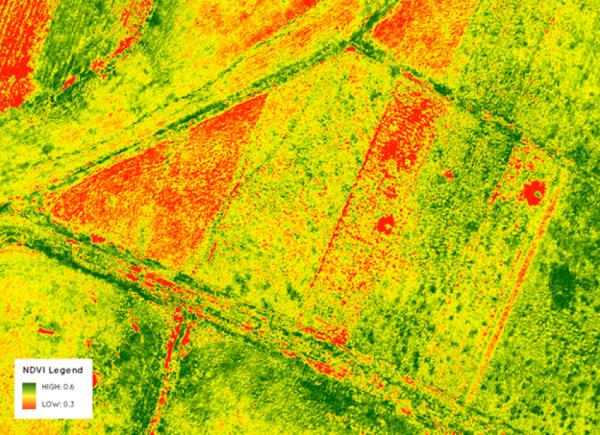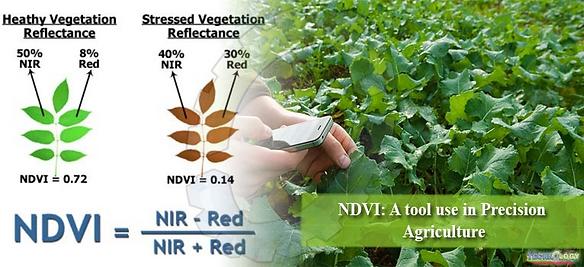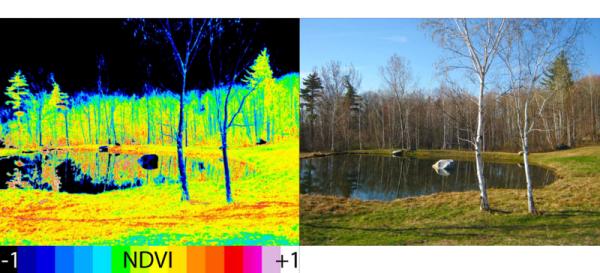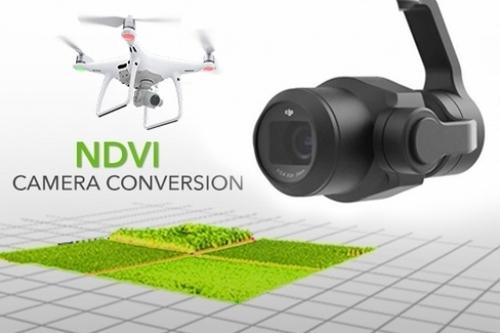NDVI stands for Normalized Difference Vegetation Index. It is an index commonly used in remote sensing and agriculture to assess and monitor the health and vigor of vegetation. NDVI measures the difference between the red and near-infrared (NIR) bands of the electromagnetic spectrum, which are captured by remote sensing devices such as satellites or drones.
The formula for calculating NDVI is:
NDVI = (NIR – Red) / (NIR + Red)
In this formula, the NIR band represents the near-infrared reflectance, and the Red band represents the red reflectance. The values range from -1 to 1, with higher values indicating healthier and more dense vegetation, while lower values represent less vegetation or bare ground.
The NDVI legend
NDVI is based on the principle that healthy vegetation reflects more near-infrared light and absorbs more red light. By comparing the two spectral bands, NDVI can effectively distinguish between different types of land cover and provide valuable information about vegetation density, growth patterns, and overall health.
It is widely used in agriculture, forestry, environmental monitoring, and other fields to monitor changes in vegetation over time, assess crop health, identify areas affected by drought or disease, and support land management decisions.
How to use NDVI in agriculture?
NDVI is a valuable tool in agriculture for monitoring crop health, optimizing resource management, and making informed decisions. Here are some ways NDVI can be used in agriculture:
Crop Health Assessment:
NDVI can provide insights into the overall health and vigor of crops. By regularly capturing NDVI data over a growing season, farmers can identify areas of stress or poor vegetation development. Low NDVI values may indicate nutrient deficiencies, disease, water stress, or pest damage. Early detection of these issues allows farmers to take corrective measures, such as targeted irrigation, fertilization, or pest control.
Application of NDVI in agriculture
Yield Prediction:
NDVI data collected throughout the growing season can help predict crop yields. By comparing NDVI values across different fields or regions within a field, farmers can identify areas with higher or lower potential yields. This information can assist in optimizing resource allocation, adjusting planting density, or implementing precision farming techniques to maximize overall productivity.
Irrigation Management:
NDVI can aid in optimizing irrigation practices. By monitoring NDVI values, farmers can determine the water needs of crops and identify areas of over- or under-irrigation. Maintaining optimal soil moisture levels based on NDVI data can help conserve water resources, reduce irrigation costs, and prevent water stress or waterlogging in plants.
Fertilizer Management:
NDVI can guide fertilizer application. By mapping NDVI values across a field, farmers can identify areas with varying nutrient requirements. High NDVI values indicate healthy and vigorously growing vegetation, while low values may suggest nutrient deficiencies. By applying fertilizers more precisely based on NDVI-guided variable rate application, farmers can improve nutrient use efficiency, minimize fertilizer waste, and promote balanced plant growth.
Disease and Pest Monitoring: NDVI can aid in early detection of diseases or pest infestations. Unhealthy plants often exhibit lower NDVI values compared to healthy plants. Regular NDVI monitoring can help identify potential problem areas, enabling timely intervention with appropriate disease management strategies or targeted pest control measures.
Field Mapping and Zoning: NDVI data can be used to create detailed vegetation maps of fields, allowing farmers to identify variations in crop health and vigor. These maps can be used to create management zones, where specific actions, such as variable rate application of inputs, can be implemented based on the specific needs of different areas within the field.
To effectively use NDVI in agriculture, farmers typically rely on remote sensing technologies, such as satellite imagery or drones, equipped with multispectral sensors capable of capturing the required spectral bands. Specialized software tools are used to process and analyze the NDVI data, allowing farmers to make informed decisions about crop management practices.
what kind of camera lenses are suitable for NDVI?
When capturing imagery for NDVI analysis, it is important to use specific camera lenses that are suitable for capturing the required spectral bands. Here are two common types of lenses used for NDVI applications:
Normal Visible Light Lens:
This type of lens captures the visible spectrum (typically ranging from 400 to 700 nanometers) and is used to capture the red band required for NDVI calculation. A standard visible light lens is suitable for this purpose as it allows capturing the visible red light that plants reflect.
Near-Infrared (NIR) Lens:
To capture the near-infrared (NIR) band, which is essential for NDVI calculation, a specialized NIR lens is needed. This lens allows capturing light in the near-infrared range (typically ranging from 700 to 1100 nanometers). It is important to ensure that the lens is capable of accurately capturing the NIR light without filtering or distorting it.
Lenses used for NDVI applications
In some cases, particularly for professional remote sensing applications, multispectral cameras are used. These cameras are equipped with multiple sensors or filters that capture specific spectral bands, including the red and NIR bands required for NDVI. Multispectral cameras provide more accurate and precise data for NDVI calculations compared to using separate lenses on a standard visible light camera.
It’s worth noting that when using a modified camera for NDVI analysis, where the camera’s internal filter has been replaced to allow for NIR capture, specific lenses optimized for capturing NIR light may not be necessary.
In conclusion, NDVI has proven to be an invaluable tool for agriculture, enabling farmers to gain critical insights into crop health, optimize resource management, and make data-driven decisions. With the ever-increasing demand for accurate and efficient NDVI analysis, it is crucial to have reliable equipment that captures the necessary spectral bands with precision.
At ChuangAn, we understand the importance of high-quality imaging technology in NDVI applications. That’s why we are proud to introduce our NDVI lenses. Designed specifically for agricultural use, our lens is engineered to capture the red and near-infrared bands with exceptional accuracy and clarity.
NDVI camera conversion
Featuring cutting-edge optics and advanced lens coatings, our NDVI lens ensures minimal light distortion, delivering reliable and consistent results for NDVI calculations. Its compatibility with a range of cameras and its easy integration make it an ideal choice for agricultural researchers, agronomists, and farmers seeking to elevate their NDVI analysis.
With ChuangAn’s NDVI lens, you can unlock the full potential of NDVI technology, empowering you to make more informed decisions about irrigation management, fertilizer application, disease detection, and yield optimization. Experience the difference in precision and performance with our state-of-the-art NDVI lens.
To learn more about our ChuangAn’s NDVI lens and explore how it can enhance your NDVI analysis, visit our website https://www.opticslens.com/ndvi-lenses-product/.
Choose ChuangAn’s NDVI lenses and take your agricultural monitoring and analysis to new heights. Discover a world of possibilities with our advanced imaging technology.
Post time: Jul-26-2023







